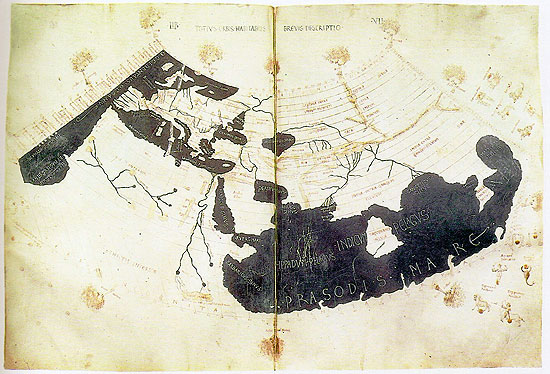Ptolemy's Geographica
by Andrew Boyd
Today, a man and a map. The University of Houston's College of Engineering presents this series about the machines that make our civilization run, and the people, whose ingenuity created them.
Most of us know the name Ptolemy for the Ptolemaic or earth-centered model of our solar system. Ptolemy's model, laid out in the second century, described the motion of the stars and planets reasonably well for the time; and his work, the Almagest, is one of the most important surviving treatises we know about early Greek astronomy.
Ptolemy believed the earth was round, which, perhaps surprisingly, wasn't a new idea even in the second century. Aristotle had argued that the earth was round some five centuries earlier. Eratosthenes devised a clever geometric experiment to actually measure the earth's diameter, and did so four centuries before the Almagest was written. And a round earth played a central role in Ptolemy's other important work, the Geographia. In the Almagest, Ptolemy laid out a map of the heavens. In theGeographia, he laid out a map of the earth.
Key to Ptolemy's earth map was the notion of latitude and longitude — a handy coordinate system for locating points on a round surface. Ptolemy didn't come up with the idea — he freely borrowed it from a contemporary, Marinos of Tyre. But he used the idea to make his own lasting contributions. Ptolemy spent a lot of effort on projection, the mathematical process of taking the earth's round surface and drawing it on a flat sheet of paper. It's not a trivial problem, and all projections distort maps in one way or another. Ptolemy didn't skirt the issue — he hit it head on.

He also compiled information from many disparate sources, providing long lists of latitudes and longitudes for important locations. And he used that information to put together an all-encompassing map of the known world. Ptolemy believed the known world covered about a quarter of the earth's surface, and he wasn't far off. His effort led to what we'd now call a world atlas — an atlas that was updated and referenced for well over a millennium.
It's easy to find problems with Ptolemy's world map. The known land masses are there, but some are wildly misshapen. Today we can call upon an elaborate global positioning system and fix the latitude and longitude of any point on earth to within about a foot. That's mind-boggling. But early civilizations couldn't come close to that. In fact, longitude couldn't be properly measured until the eighteenth century, when sufficiently accurate clocks were devised — clocks that kept good time as they were shaken and rattled while moving from one point to another.
But what really stands out in Ptolemy's world map are the beautiful, gently curving lines of latitude — a clear, visual reminder that we live on the surface of a ball, and that we've known it for thousands of years.

I'm Andy Boyd at the University of Houston, where we're interested in the way inventive minds work.
(Theme music)
Notes and references:
For related episodes, see 230, THE ROUND EARTH, and 235, HARRISON'S TIMEPIECE.
Geography (Ptolemy). From the Wikipedia Web site: https://en.wikipedia.org/wiki/Geography_%28Ptolemy%29. Accessed March 23, 2010.
D. Sobel. Longitude: The True Story of a Lone Genius Who Solved the Greatest Scientific Problem of His Time. New York: Walker and Company, 1995.
The mathematical figure of Ptolemy's map projection is taken from the translation of Geographia found at the Oxford University Computing Services Web site.
Most unfortunately, while copies of the text of the Geographia were handed down through the ages (with changes and additions as new and better data became available), none of Ptolemy's original maps are known to have survived. However, Ptolemy provided an adequate description to allow later cartographers to recreate faithful reproductions — especially with respect to the projection, which Ptolemy carefully described. The map presented here, taken from Wikimedia Commons, is a fifteenth century rendition of Ptolemy's world map.